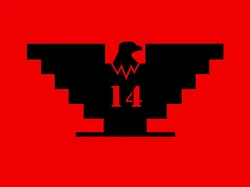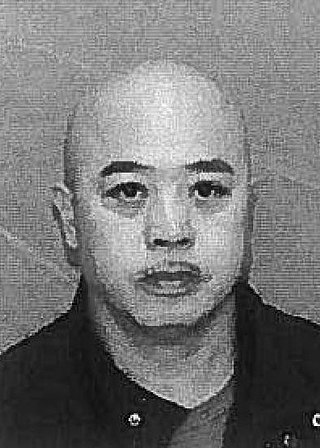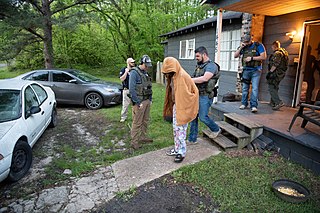Related Research Articles

San Francisco, officially the City and County of San Francisco, is the commercial, financial, and cultural center of Northern California. The city proper is the fourth most populous city in California, with 808,437 residents, and the 17th most populous city in the United States as of 2022. The city covers a land area of 46.9 square miles at the end of the San Francisco Peninsula, making it the second-most densely populated large U.S. city after New York City and the fifth-most densely populated U.S. county, behind only four of the five New York City boroughs. Among the 92 U.S. cities proper with over 250,000 residents, San Francisco was ranked first by per capita income and sixth by aggregate income as of 2022. Colloquial nicknames for San Francisco include Frisco, San Fran, The City, and SF.

Norteños are the various, affiliated gangs that pay tribute to Nuestra Familia while in California state and federal correctional facilities. Norteños may refer to Northern California as Norte Califas. Their biggest rivals are the Sureños from Southern California. As of 2008, the statewide north–south dividing line between Norteños and Sureños was regarded as running through the southern end of the Central Valley. The gang's membership consists primarily of Mexican Americans.
Westmob, is a primarily African-American street gang located in San Francisco, California. Since 1999, they have been in conflict against the Big Block gang which is its major rival in the area. Westmob is known to associate with the Oakdale Mob and Sunnydale Gangsters. Its rivalry with Big Block was the subject of the 2002 documentary Straight Outta Hunter's Point and is linked to rap and drugs. They claim territory from West Point to Middle Point in San Francisco's notoriously dangerous Hunters Point projects.
Like many other communities, the older Chinatowns face certain social problems. Although Chinatowns are now generally viewed and valued as tourist attractions, their earlier reputation was that of dangerous or dilapidated ghettos and slums, sites of brothels, opium dens, and gambling halls.

The Golden Dragon massacre was a gang-related mass shooting that took place on September 4, 1977, inside the Golden Dragon Restaurant at 822 Washington Street in Chinatown, San Francisco, California, United States. The five perpetrators, members of the Joe Boys, a Chinese youth gang, were attempting to kill leaders of the Wah Ching, a rival Chinatown gang. The attack left five people dead and 11 others injured, none of whom were gang members. Seven perpetrators were later convicted and sentenced in connection with the murders. The massacre led to the establishment of the San Francisco Police Department's Asian Gang Task Force, credited with ending gang-related violence in Chinatown by 1983. The restaurant itself closed in 2006.

Wah Ching, meaning Chinese Youth, is a Chinese American criminal organization and street gang that was founded in San Francisco, California in 1964. The Wah Ching has been involved in crimes including narcotic sales, racketeering and gambling.
Crime has been recorded in the United States since its founding and has fluctuated significantly over time, with a sharp rise after 1900 and reaching a broad bulging peak between the 1970s and early 1990s. After 1992, crime rates have generally trended downwards each year, with the exceptions of a slight increase in property crimes in 2001 and increases in violent crimes in 2005-2006, 2014-2016 and 2020-2021. While official federal crime data beginning in 2021 has a wide margin of error due to the incomplete adoption of the National Incident-Based Reporting System by government agencies, federal data for 2020-2021 and limited data from select U.S. cities collected by the nonpartisan Council on Criminal Justice showed significantly elevated rates of homicide and motor vehicle theft in 2020-2022. Although overall crime rates have fallen far below the peak of crime seen in the United States during the late 1980s and early 1990s, the homicide rate in the U.S. has remained high, relative to other "high income"/developed nations, with eight major U.S. cities ranked among the 50 cities with the highest homicide rate in the world in 2022. The aggregate cost of crime in the United States is significant, with an estimated value of $4.9 trillion reported in 2021. Data from the first half of 2023, from government and private sector sources show that the murder rate has dropped, as much as 12% in as many as 90 cities across the United States. The drop in homicide rates is not uniform across the country however, with some cities such as Memphis, TN, showing an uptick in murder rates.

The Tenderloin is a neighborhood in downtown San Francisco, in the flatlands on the southern slope of Nob Hill, situated between the Union Square shopping district to the northeast and the Civic Center office district to the southwest. Encompassing about 50 square blocks, it is historically bounded on the north by Geary Street, on the east by Mason Street, on the south by Market Street and on the west by Van Ness Avenue. The northern boundary with Lower Nob Hill has historically been set at Geary Street.
The San Francisco Police Department began operations on August 13, 1849 during the California Gold Rush under the command of Captain Malachi Fallon. At the time, Chief Fallon had a force of one deputy captain, three sergeants, and thirty officers.

Raymond Kwok-Cheung Chow, nicknamed "Shrimp Boy", is a Hong Kong-born felon with ties to a San Francisco Chinatown street gang and an organized crime syndicate, including the American branch of the Hong Kong-based triad Wo Hop To and the Hop Sing Boys.
The murder of the Bologna family occurred on June 22, 2008, when Anthony Bologna and his sons, Michael and Matthew, were shot dead near their residence in the Excelsior district of San Francisco, California, by Edwin Ramos Umaña, who mistook the victims as rival gang members for whom he wanted retaliation.

Chesa Boudin is an American lawyer who served as the 29th District Attorney of San Francisco from January 8, 2020 to July 8, 2022. He is a member of the Democratic Party.
Crime in Atlanta, Georgia is above the national median and has been a major problem for the city since the middle 20th century.
Crime in California refers to crime occurring within the U.S. state of California.
In 2019, 43,686 crimes were reported in the U.S. state of Michigan. Crime statistics vary widely by location. For example, Dearborn has a murder rate of only 2.1 per 100,000 while sharing borders with Detroit and Inkster, some of the highest rates in the state.
The Jackson Boyz, JBZ or Jackson Street Boys, JSB are or were a San Francisco, California based Asian American street gang and criminal organization The gang, composed of Cantonese and Vietnamese members, has been centered in San Francisco's Chinatown, and was named for Jackson Street. The Jackson Street Boys also have a presence in other U.S. cities.
Crime in Oakland, California, began to rise during the late 1960s, and by the end of the 1970s Oakland's per capita murder rate had risen to twice that of San Francisco or New York City. In 1983, the National Journal referred to Oakland as the "1983 crime capital" of the San Francisco Bay Area. Crime continued to escalate during the 1980s and 1990s, and during the first decade of the 21st century Oakland has consistently been listed as one of the most dangerous large cities in the United States.
African Americans in San Francisco, California, composed just under 6% of the city's total population as of 2019 U.S. Census Bureau estimates, down from 13.4% in 1970. There are about 55,000 people of full or partial black ancestry living within the city. The community began with workers and entrepreneurs of the California Gold Rush in the 19th century, and in the early-to-mid 20th century, grew to include migrant workers with origins in the Southern United States, who worked as railroad workers or service people at shipyards. In the mid-20th century, the African American community in the Fillmore District earned the neighborhood the nickname the "Harlem of the West," referring to New York City's Harlem neighborhood, which is associated with African American culture.

Operation Devil Horns was a four-year-long criminal investigation run by Homeland Security Investigations (HSI), culminating in the arrests and convictions of more than three dozen members of the MS-13 gang in San Francisco. It is one of the largest such cases of its kind in U.S. history.
Joe Fong is a Macanese-American former gang leader who founded and led the Chung Ching Yee gang in Chinatown, San Francisco from 1971 until his arrest and incarceration in 1973, when he was eighteen years old. After his release in 1979, Fong attended college and graduate school.
References
- ↑ "Key facts about crime in San Francisco". The San Francisco Chronicle. Retrieved 1 May 2023.
- ↑ Demian Bulwa (January 5, 2012). "Through hard times, S.F. killings at historic lows". San Francisco Chronicle. Retrieved July 29, 2013.
- ↑ "San Francisco crime rates and statistics". NeighborhoodScout. Retrieved July 29, 2013.
- ↑ "The Tenderloin". FoundSF. Retrieved July 29, 2013.
- ↑ Vivian Ho (July 4, 2015). "Bay Area homicide rates remain low". San Francisco Chronicle.
- ↑ Bodley, Michael (January 4, 2017). "SF cops say they notch 2 arrests in last 2 homicides of 2016." SFGate. Retrieved January 17, 2017.
- ↑ San Francisco DA Says Few Auto Smash-and-Grab Burglaries End With An Arrest Betty Yu, CBS, November 10, 2021
- ↑ Swan, Rachel (September 13, 2022). "Here's how many San Franciscans say they've been the victim of a crime, according to new poll". San Francisco Chronicle. Retrieved October 16, 2022.
- 1 2 3 4 Baggarly, Andrew (December 12, 2023). "Shohei Ohtani turned down Giants' $700M offer. Buster Posey reflects on team's 'free-agent slump'". The Athletic. Retrieved December 16, 2023.
- ↑ "La Mara Salvatrucha Street Gang – San Francisco". Sfweekly.com. Archived from the original on July 26, 2013. Retrieved July 29, 2013.
- ↑ Bulwa, Demian (May 27, 2005). "SAN FRANCISCO / Sureño gang's threat growing in Bay Area / Widow's apartment is at heart of group's Mission District turf". San Francisco Chronicle. Retrieved March 29, 2014.
- ↑ Albert Samaha (September 26, 2012). "Crip-less: S.F.'s Dislike of Franchises Extends to Street Gangs – Page 1 – News – San Francisco". SF Weekly. Retrieved July 29, 2013.
- ↑ Chris Roberts (December 2015). "Mario Woods and Gang Injunctions". SF Weekly. Retrieved September 5, 2016.
- ↑ "Straight Outta Hunter's Point DVD". Archived from the original on September 14, 2012. Retrieved September 14, 2012.
- ↑ Sward, Susan (December 16, 2001). "THE KILLING STREETS / A Cycle of Vengeance / BLOOD FEUD / In Bayview-Hunters Point, a series of unsolved homicides has devastated one of S.F.'s most close-knit communities". SFGATE.
- ↑ Van Derbeken, Jaxon; Lagos, Marisa; Buchanan, Wyatt (April 20, 2007). "AK-47 cop killer gets life". San Francisco Chronicle.
- ↑ Mary Spicuzza (August 1, 2007). "Enter The Dragon". SF Weekly. Retrieved September 5, 2016.
- ↑ Vanessa Hua (October 7, 2006). "Golden Dragon Closes and owes a million". San Francisco Chronicle. Retrieved December 6, 2011.
- ↑ Jim Herron Zamora (May 15, 1990). "S.F. Chinatown Shootings May Be Tied to Gang". Los Angeles Times. Retrieved September 16, 2012.
- ↑ Vanessa Hua (June 20, 1998). "Boy, 16, Arrested in S.F. Chinatown Shooting Rampage / Suspect was at scene but didn't fire gun, cops say". San Francisco Chronicle. Retrieved September 16, 2012.